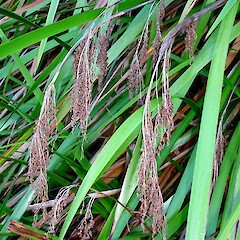Machaerina sinclairii
Common name
machaerina
Synonyms
Vincentia anceps Hook.f., Cladium sinclairii Hook.f., Cladium gahnoides Colenso, Vincentia sinclairii (Hook.f.) Hamlin
Family
Cyperaceae
Flora category
Vascular – Native
Endemic taxon
No
Endemic genus
No
Endemic family
No
Structural class
Sedges
NVS code
The National Vegetation Survey (NVS) Databank is a physical archive and electronic databank containing records of over 94,000 vegetation survey plots - including data from over 19,000 permanent plots. NVS maintains a standard set of species code abbreviations that correspond to standard scientific plant names from the Ngä Tipu o Aotearoa - New Zealand Plants database.
MACSIN
Chromosome number
2n = c.30
Current conservation status
The conservation status of all known New Zealand vascular plant taxa at the rank of species and below were reassessed in 2017 using the New Zealand Threat Classification System (NZTCS) – more information about this can be found on the NZTCS website. This report includes a statistical summary and brief notes on changes since 2012 and replaces all previous NZTCS lists for vascular plants.
Please note, threat classifications are often suggested by authors when publications fall between NZTCS assessment periods – an interim threat classification status has not been assessed by the NZTCS panel.
- Conservation status of New Zealand indigenous vascular plants, 2017 . 2018. Peter J. de Lange, Jeremy R. Rolfe, John W. Barkla, Shannel P. Courtney, Paul D. Champion, Leon R. Perrie, Sarah M. Beadel, Kerry A. Ford, Ilse Breitwieser, Ines Schönberger, Rowan Hindmarsh-Walls, Peter B. Heenan and Kate Ladley. Department of Conservation. Source: NZTCS and licensed by DOC for reuse under the Creative Commons Attribution 4.0 International licence.
2017 | Not Threatened
Previous conservation statuses
2012 | Not Threatened
2009 | Not Threatened
2004 | Not Threatened
Distribution
North Island only from Northland to the northern Remutaka Range. Also recorded from Malaysia.
Habitat
Coastal to montane (up to 900 m a.s.l.). usually in seepages draining cliff faces where it is often the dominant vegetative cover. Although favouring sunny situations, Machaerina is equally at home around cave entrances, and within tall forest along river banks, stream sides and steep gorges. Occasionally it colonises permanently damp sites within dense forest.
Wetland plant indicator status rating
Information derived from the revised national wetland plant list prepared to assist councils in delineating and monitoring wetlands (Clarkson et al., 2021 Manaaki Whenua – Landcare Research Contract Report LC3975 for Hawke’s Bay Regional Council). The national plant list categorises plants by the extent to which they are found in wetlands and not ‘drylands’. The indicator status ratings are OBL (obligate wetland), FACW (facultative wetland), FAC (facultative), FACU (facultative upland), and UPL (obligate upland). If you have suggestions for the Wetland Indicator Status Rating, please contact: [Enable JavaScript to view protected content]
OBL: Obligate Wetland
Almost always is a hydrophyte, rarely in uplands (non-wetlands).
Detailed description
Stout, leafy sedge. Culms 0.5–1.2 m long, 3–5 mm wide, smooth, laterally compressed flaccid. Leaves numerous, suberect, spreading with upper ½ to ⅓ distinctly flaccid, 0.3–2.5 m long, 10–35 mm wide, flat, smooth, lustrous, pale to dark green, tapering to an acuminate apex, margins smooth. Panicle 150–480 mm long, pendulous, much-branched; lowermost sheathing bract with ciliate mouth and lamina up to 30 mm long; branches in fascicles from upper sheaths. Spikelets numerous, 3–4 mm long, in small fascicles towards the tips of the branchlets, red-brown, 2–4-flowered, usually the lowest 1–2 flowers fertile. Glumes 5–7, ovate-lanceolate, acuminate to almost awned, scabrid-pubescent, lower 2–3 sterile. Hypogynous bristles 0. Stamens elongating after flowering, filaments bright red-brown. Nut (including beak) 2.0–2.5 mm long, < 1 mm wide, acutely trigonous, almost winged, fusiform, brown,. narrowed above and below to a prominent 3-angled beak and stipe each more or less = to body of nut in length.
Similar taxa
Machaerina complanata is somewhat similar but has much narrower (4–8 mm cf. 10–30–(40) mm) leaves, and more open, less pendulous, erect to suberect, non-fluffy inflorescences rather than the distinctive fluffy brown more pendulous ones typical of Machaerina. The style base of Machaerina complanata is usually turgid, much shorter than the nut and usually inconspicuous while in Machaerina sinclairii the style-base is about the same length as the nut, and though rather narrow is quite conspicuous. Macaherina complanata and M. sinclairii have so far never been found growing sympatrically.
Flowering
September–December
Fruiting
November–April (but old inflorescences present throughout the year)
Propagation technique
Very easily grown from fresh seed and by the division of established plants. An attractive sedge that is now frequently available from most garden centres and plant nurseries. It does best in a permanently damp soil but is tolerant of full sub or shade. However, plants flower best in full sun. A beautiful plant to establish around ponds and streams.
Etymology
sinclairii: After Sinclair (c. 1796–1861). Colonial Secretary and naturalist.
Where To Buy
Commonly available from mainline and specialist native plant nurseries.
Attribution
Fact sheet prepared for NZPCN by P.J. de Lange (8 September 2006). Description adapted from Moore & Edgar (1970)
References and further reading
Moore LB, Edgar E. 1970. Flora of New Zealand, Volume II. Indigenous Tracheophyta: Monocotyledones except Gramineae. Government Printer, Wellington, NZ. 354 p.
NZPCN Fact Sheet citation
Please cite as: de Lange, P.J. (Year at time of access): Machaerina sinclairii Fact Sheet (content continuously updated). New Zealand Plant Conservation Network. https://www.nzpcn.org.nz/flora/species/machaerina-sinclairii/ (Date website was queried)










